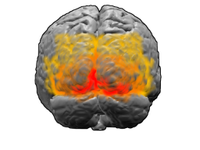
Photo from wikipedia
Significance The integration of visual information over space is critical to human pattern vision. For either luminance detection or object recognition, the position of the target in the visual field… Click to show full abstract
Significance The integration of visual information over space is critical to human pattern vision. For either luminance detection or object recognition, the position of the target in the visual field governs the size of a window within which visual information is integrated. Here we analyze the relationship between the topographic distribution of ganglion cell density and the nonuniform spatial integration across the visual field. We find that the variation in the retinal ganglion cell (RGC) density across the human retina is closely matched to the variation in the extent of spatial integration. Our study suggests that a fixed number of RGCs subserves spatial integration of visual input, independent of the visual-field location. The ability to integrate visual information over space is a fundamental component of human pattern vision. Regardless of whether it is for detecting luminance contrast or for recognizing objects in a cluttered scene, the position of the target in the visual field governs the size of a window within which visual information is integrated. Here we analyze the relationship between the topographic distribution of ganglion cell density and the nonuniform spatial integration across the visual field. The extent of spatial integration for luminance detection (Ricco’s area) and object recognition (crowding zone) are measured at various target locations. The number of retinal ganglion cells (RGCs) underlying Ricco’s area or crowding zone is estimated by computing the product of Ricco’s area (or crowding zone) and RGC density for a given target location. We find a quantitative agreement between the behavioral data and the RGC density: The variation in the sampling density of RGCs across the human retina is closely matched to the variation in the extent of spatial integration required for either luminance detection or object recognition. Our empirical data combined with the simulation results of computational models suggest that a fixed number of RGCs subserves spatial integration of visual input, independent of the visual-field location.
Journal Title: Proceedings of the National Academy of Sciences of the United States of America
Year Published: 2019
Link to full text (if available)
Share on Social Media: Sign Up to like & get
recommendations!